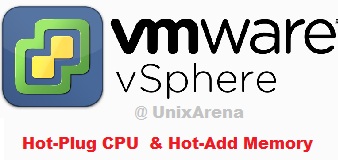VMware vSphere’s hot-add Memory and hot-plug CPU functions allow you to add the CPU and Memory while virtual machine is up and running. It will help you to add the additional resources whenever required and no need to bring down the VM for each time.But you can’t remove the resources once you have added the VM while its running.This Hot-add RAM and Hot-plug CPU will work on specific version of windows server operating systems.(Windows Server 2008 ) I have tested this features on Redhat Enterprise Linux 6.3 and it works like charm. These featutures are heavily depends on the guest operating systems kernel and most of the Unix Like operating system’s kernel can recognize the hardware changes quickly and it will start using it.
[box type=”info” ]Enterprise Operating systems like Oracle Solaris , IBM AIX and HP-UX supports these features from over the decade with help of their own RISC architecture hardwares.[/box]
In this article ,we will see that how we can enable the hot-plug CPU and Hot-add RAM on existing VM .
Enabling the VMware vSphere Hot-plug CPU & Hot-Add RAM Feature
1. Login to the VMware vSphere Client and Halt the VM .
2.Right click the VM and edit the virtual machine settings.
3.Expand the CPU tab like below.
4.Navigate to CPU hot Plug option .
5.Select the “Enable CPU Hot Add” Box.
6.Same way you can configure for memory as well. Just enable the Memory Hot plug like below. So that you can add the memory to the virtual machine while its running.
7.Once you have done the above settings just power on the system. Now your VM can support the Hot-plug CPU & Hot-Add RAM features of VMware vSphere.
Testing the VMware vSphere Hot-plug CPU & Hot-Add RAM
1.Login the VM and check the current CPU & Memory information.(RHEL 6)
CPU:
[root@UAWEB1 ~]# lscpu Architecture: x86_64 CPU op-mode(s): 32-bit, 64-bit Byte Order: Little Endian CPU(s): 1 On-line CPU(s) list: 0 Thread(s) per core: 1 Core(s) per socket: 1 CPU socket(s): 1 NUMA node(s): 1 Vendor ID: GenuineIntel CPU family: 6 Model: 58 Stepping: 9 CPU MHz: 2893.459 BogoMIPS: 5786.91 L1d cache: 32K L1i cache: 32K L2 cache: 256K L3 cache: 3072K NUMA node0 CPU(s): 0 [root@UAWEB1 ~]#
Memory:
[root@UAWEB1 ~]# free -m
total used free shared buffers cached
Mem: 1869 211 1658 0 11 74
-/+ buffers/cache: 125 1744
Swap: 4031 0 4031
[root@UAWEB1 ~]#
2.Go Back to VMware vSphere Client console and edit the virtual Machine to increase the memory.(Increased from 2048 to 2560).Click OK to save the settings.
3.Execute the below command on VM guest to see whether newly added memory is reflecting or not.
[root@UAWEB1 ~]# free -m
total used free shared buffers cached
Mem: 2381 221 2160 0 11 74
-/+ buffers/cache: 135 2246
Swap: 4031 0 4031
[root@UAWEB1 ~]#
We can see that total memory has been increased 500MB. Which means Hot RAM feature is working fine on RHEL 6.x
4.Let me increase the number of virtual CPU for the VM guest.
5.Check on the CPU information on RHEL VM.
[root@UAWEB1 ~]# lscpu Architecture: x86_64 CPU op-mode(s): 32-bit, 64-bit Byte Order: Little Endian CPU(s): 2 On-line CPU(s) list: 0,1 Thread(s) per core: 1 Core(s) per socket: 1 CPU socket(s): 2 NUMA node(s): 1 Vendor ID: GenuineIntel CPU family: 6 Model: 58 Stepping: 9 CPU MHz: 2893.459 BogoMIPS: 5786.91 L1d cache: 32K L1i cache: 32K L2 cache: 256K L3 cache: 3072K NUMA node0 CPU(s): 0,1 [root@UAWEB1 ~]#
We can see that CPU(s) count has been increased from 1 to 2.
Why VMware is not enabling the Hot Memory & Hot CPU feature by default ? There is an little overhead by enabling the features. That’s why customers need to decides whether they require this feature or not.
Thank you for visiting UnixArena
Share it ! Comment it !! Be Sociable !!!
